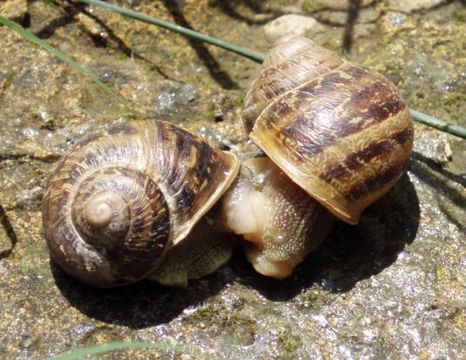Reproduction
Little information is known about the specific reproductive patterns of Inflectarius ferrissi; however, we can safely assume that there are many similarities to terrestrial snails. In particular, terrestrial snails have a direct life cycle as compared to larval life cycles found in marine snails (Hickman et al., 2009). With a direct life style, juveniles emerge as miniature adults where torsion and coiling have already occurred in the embryonic development life stages (Hickman et al., 2009).
Terrestrial snails are also predominantly monoecious, latin for one house,
which is also termed hermaphroditic (Hotopp, 2006).
 This means that
terrestrial snails possess both male and female reproductive organ systems and
serve as both sperm producers and egg bearers (Hotopp, 2006).
Even though self-fertilization is possible, normal reproductive patterns
are sexual between two organisms of the same species (Dourson, 2006). This allows for more genetic diversity and also results in both practicing organisms to go on and lay eggs (Hotopp, 2006).
Unlike normal mammals, snails perform sexual reproduction internally by
means of copulation (Hotopp, 2006).
Copulation is described as the sexual union to facilitate genetic exchange
and fertilization (Hickman et al., 2009).
In the case of snails, the genital pore's ot the two practicing snails are
brought next to each other, for most, this positions the snails facing
opposite of each other with the right sides of their heads together
(Hotopp, 2006).
This means that
terrestrial snails possess both male and female reproductive organ systems and
serve as both sperm producers and egg bearers (Hotopp, 2006).
Even though self-fertilization is possible, normal reproductive patterns
are sexual between two organisms of the same species (Dourson, 2006). This allows for more genetic diversity and also results in both practicing organisms to go on and lay eggs (Hotopp, 2006).
Unlike normal mammals, snails perform sexual reproduction internally by
means of copulation (Hotopp, 2006).
Copulation is described as the sexual union to facilitate genetic exchange
and fertilization (Hickman et al., 2009).
In the case of snails, the genital pore's ot the two practicing snails are
brought next to each other, for most, this positions the snails facing
opposite of each other with the right sides of their heads together
(Hotopp, 2006).
When ready, snails will expel their eggs out into a selectively moist environment (Hotopp, 2006). Terrestrial snails generally lay their eggs in various damp, well protected locations, although specifics may vary with specific species (Hotopp, 2006). Some general locations include under damp logs and within deep moist leaf litter (Dourson, 2006). Some species have been known to lay their eggs in dug out holes as well(Hotopp, 2006).
Snail eggs appear white and translucent and are generally are no larger than a few millimeters (Hotopp, 2006). Depending on the specific species, egg characteristics range from hard to rubbery, scattered to clustered, and vary with particular sizes (Hotopp, 2006). A few weeks after laid, baby snails will begin to emerge and begin their life (Hotopp, 2006).
To read more about general terrestrial snails, visit Carnegie Museum of Natural History
Inflectarius ferrissi Interactions